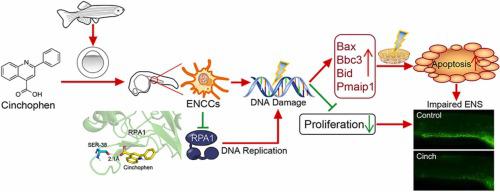当前位置:
X-MOL 学术
›
Ecotox. Environ. Saf.
›
论文详情
Our official English website, www.x-mol.net, welcomes your
feedback! (Note: you will need to create a separate account there.)
Cinchophen induces RPA1 related DNA damage and apoptosis to impair ENS development of zebrafish
Ecotoxicology and Environmental Safety ( IF 6.2 ) Pub Date : 2024-02-01 , DOI: 10.1016/j.ecoenv.2024.116032 Jing Wang 1 , Xinyao Meng 1 , Xuyong Chen 1 , Jun Xiao 1 , Xiaosi Yu 1 , Luyao Wu 1 , Zejian Li 2 , Ke Chen 1 , Xuan Zhang 3 , Bo Xiong 4 , Jiexiong Feng 1
Ecotoxicology and Environmental Safety ( IF 6.2 ) Pub Date : 2024-02-01 , DOI: 10.1016/j.ecoenv.2024.116032 Jing Wang 1 , Xinyao Meng 1 , Xuyong Chen 1 , Jun Xiao 1 , Xiaosi Yu 1 , Luyao Wu 1 , Zejian Li 2 , Ke Chen 1 , Xuan Zhang 3 , Bo Xiong 4 , Jiexiong Feng 1
Affiliation

|
Nonsteroidal anti-inflammatory drugs (NSAIDs) have become contaminants widely distributed in the environment due to improper disposal and discharge. Previous study has found several components might involve in impairing enteric nervous system (ENS) development of zebrafish, including NSAIDs cinchophen. Deficient ENS development in fetal could lead to Hirschsprung disease (HSCR), a congenital neurocristopathy characterized by absence of enteric neurons in hindgut. However, the intrinsic mechanism of neurotoxicity of cinchophen is unclear. We confirmed that cinchophen could impair ENS development of zebrafish and transcriptome sequencing revealed that disfunction of Replication protein A1 (RPA1), which is involved in DNA replication and repairment, might be relevant to the neurotoxicity effects induced by cinchophen. Based on previous data of single cell RNA sequencing (scRNA-seq) of zebrafish gut cells, we observed that rpa1 mainly expressed in proliferating, differentiating ENS cells and neural crest progenitors. Interestingly, cinchophen induced apoptosis and impaired proliferation. Furthermore, cinchophen caused DNA damage and abnormal activation of ataxia telangiectasia mutated/ Rad3 related (ATM/ATR) and checkpoint kinase 2 (CHK2). Finally, molecular docking indicated cinchophen could bind and antagonize RPA1 more effectively. Our study might provide a better understanding and draw more attention to the role of environmental factors in the pathogenesis of HSCR. And the mechanism of cinchophen neurotoxicity would give theoretical guidance for clinical pharmacy.
中文翻译:

Cinchophen 诱导 RPA1 相关 DNA 损伤和细胞凋亡,损害斑马鱼 ENS 发育
由于处置和排放不当,非甾体抗炎药(NSAIDs)已成为广泛分布在环境中的污染物。此前的研究发现,多种成分可能会损害斑马鱼肠神经系统(ENS)的发育,其中包括非甾体抗炎药辛可芬(cinchophen)。胎儿 ENS 发育缺陷可能导致先天性巨结肠症 (HSCR),这是一种先天性神经弯曲病,其特征是后肠缺乏肠神经元。然而,cinchophen 神经毒性的内在机制尚不清楚。我们证实,cinchophen 可能会损害斑马鱼的 ENS 发育,转录组测序表明,参与 DNA 复制和修复的复制蛋白 A1 (RPA1) 的功能障碍可能与 cinchophen 引起的神经毒性作用有关。基于之前对斑马鱼肠道细胞的单细胞RNA测序(scRNA-seq)数据,我们观察到rpa1主要在增殖、分化的ENS细胞和神经嵴祖细胞中表达。有趣的是,辛乔芬诱导细胞凋亡并损害增殖。此外,cinchophen 会导致 DNA 损伤以及共济失调毛细血管扩张突变/Rad3 相关 (ATM/ATR) 和检查点激酶 2 (CHK2) 的异常激活。最后,分子对接表明cinchophen可以更有效地结合和拮抗RPA1。我们的研究可能会提供更好的理解并引起人们更多的关注环境因素在 HSCR 发病机制中的作用。辛可芬的神经毒性机制可为临床药学提供理论指导。
更新日期:2024-02-01
中文翻译:

Cinchophen 诱导 RPA1 相关 DNA 损伤和细胞凋亡,损害斑马鱼 ENS 发育
由于处置和排放不当,非甾体抗炎药(NSAIDs)已成为广泛分布在环境中的污染物。此前的研究发现,多种成分可能会损害斑马鱼肠神经系统(ENS)的发育,其中包括非甾体抗炎药辛可芬(cinchophen)。胎儿 ENS 发育缺陷可能导致先天性巨结肠症 (HSCR),这是一种先天性神经弯曲病,其特征是后肠缺乏肠神经元。然而,cinchophen 神经毒性的内在机制尚不清楚。我们证实,cinchophen 可能会损害斑马鱼的 ENS 发育,转录组测序表明,参与 DNA 复制和修复的复制蛋白 A1 (RPA1) 的功能障碍可能与 cinchophen 引起的神经毒性作用有关。基于之前对斑马鱼肠道细胞的单细胞RNA测序(scRNA-seq)数据,我们观察到rpa1主要在增殖、分化的ENS细胞和神经嵴祖细胞中表达。有趣的是,辛乔芬诱导细胞凋亡并损害增殖。此外,cinchophen 会导致 DNA 损伤以及共济失调毛细血管扩张突变/Rad3 相关 (ATM/ATR) 和检查点激酶 2 (CHK2) 的异常激活。最后,分子对接表明cinchophen可以更有效地结合和拮抗RPA1。我们的研究可能会提供更好的理解并引起人们更多的关注环境因素在 HSCR 发病机制中的作用。辛可芬的神经毒性机制可为临床药学提供理论指导。


















































 京公网安备 11010802027423号
京公网安备 11010802027423号